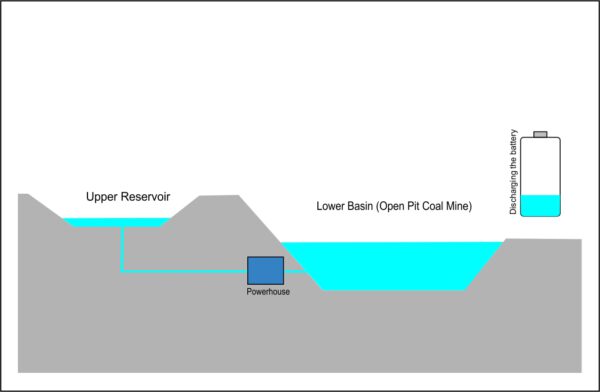
Ershad was born and grew up in Jamalpur, Bangladesh. Later on, he moved to Dhaka, Bangladesh where he obtained both Bachelor of Science (B.Sc.) & Master of Science (M.S.) degrees in Geological Sciences from Jahangirnagar University. Next, he came to Germany and pursued an (M.Sc.) degree in Earth Sciences at the University of Greifswald, Germany. Now, he is a scientific assistant at the Department of Engineering Geology, Technische Universität Berlin. There, his project focuses on repurposing abandoned open-pit coal mines as a hybrid pumped-hydro power storage (HPHS). As a part of the project, he is analysing the operational impacts of HPHS on slope stability, surface displacements, and erosion within the mine area.
Here you can connect with Ershad on LinkedIn and ResearchGate.
Background
The global energy production system is rapidly phasing out fossil fuels and elevating renewable energy. Due to the rapid fall of their generation costs, the world is aiming to boost power generation from solar radiation and wind. As solar radiation and wind are nonlinear power sources, power generation falls and rises depending on the obtained sunshine and wind. To provide electricity linearly, the system needs to store excess energy during off-peak hours and resupply it when the electricity demand is high. There are several proven energy storage technologies on the market, but most of them are not feasible for the long term and on an industrial scale. Pumped-hydro power storage (PHS) is a well-established technology that can be implemented on such a scale. Consequently, the global PHS market is growing rapidly. The current global PHS market size, for instance, is about USD 361 billion and by 2028, it could reach USD 640 billion and installation capacity will cross 300 GW (Global Market Insights; Statista; 2022). Topography is the main constraint to installing the PHS facilities. Abandoned open pit coal mines have the potential to meet these topographical constraints and they could be repurposed to resolve this issue. In the EU RFCS funded project ATLANTIS (An interdisciplinary feasibility study on hybrid pumped-hydro power storage of excess energy In open-pit coal mines), we are currently investigating the feasibility of repurposing open pit coal mines for hybrid pumped-hydro power storage (HPHS).
What is a pumped-hydro power storage system?
The over a hundred years old PHS technology was first used in Italy and Switzerland in 1890. In a PHS system, there are two water reservoirs placed at two different elevations. The reservoir placed at the higher elevation is called the upper reservoir and the reservoir placed at the lower elevation is called the lower reservoir (see figure 1 & figure 2). The reservoirs remain connected to each other with a tunnel or penstock, through which the reservoir can be recharged or discharged. The PHS system works like a giant battery, which can store power and release it on demand. To store the energy, the pump uses electricity to bring the water from the lower reservoir to fill the upper reservoir, similar to recharging the battery. To generate electricity, the water flows from the upper reservoir to the lower reservoir and passes through the turbine to discharge the battery.


How could open pit coal mines be repurposed as HPHS?
The present research plans to use open pit coal mines as HPHS, where the mine pit is considered the lower reservoir and the upper reservoir could be constructed in a suitable location at the ground surface (see figure 1 & figure 2). Both reservoirs will be connected through a powerhouse with penstocks or tunnels. Besides the topographic conditions, this hybrid set-up has many advantages, such as the availability of infrastructure in a coal mining and power generation area and the availability of space for installing renewable energy infrastructure, like solar and wind power facilities in a post-mining setting. However, filling the mine pit, an unsealed basin, with water, as well as the fluctuations in the water table during the HPHS operation could also come with environmental risks. Due to the connection to the local aquifers, groundwater quality around the open pit coal mine will be affected. Likewise, the hydrostatic pressure variations will exert influence on the lower reservoir slope stability, and erosion might occur due to drag forces of the flowing water. Consequently, the present research will put emphasis on understanding the geological, hydrogeological, and geochemical implications of HPHS operation in open pit mines and finally assess the feasibility of such an endeavour. Our focus in this study is the geotechnical risk, such as slope stability and erosion.
Slope stability analysis
Slope failure is a critical issue in open pit mines and the embankment of any structures. Slope failure could cause risk of life, production losses and economic losses in the mine during the operation. Apart from this, slope failure in a large lake or water reservoir can cause a tsunami and damage the properties close to it. Slope failure occurs, when the load on the slope is greater than the strength of the slope, which acts through the rock or soil. Several factors (e.g. groundwater, earthquakes, vibration) are involved in adding loads on the slope and triggering slope failure. Groundwater adds additional load to the soil, increasing the driving forces and reducing the soil strength. Reservoir water also plays an
important role in slope stability, fluctuation of the reservoir water level mainly controls the hydrostatic pressure (see figure 3 & figure 4) on the slope and the porewater pressure within the slope. Additionally, earthquakes accelerate slope failure because they add extra slope load.


The HPHS slope stability challenge
During the HPHS operation, both reservoirs experience water level fluctuations due to the recharging and discharging of the reservoirs. The recharge and discharge depend on the electricity generation and consumption. The water level fluctuations imply fluctuations of hydrostatic pressure in both reservoirs (see figure 3 & figure 4), which could make the slope unstable and endanger structures (see figure 5) in and on the slope around the reservoir. To tackle the influence of hydrostatic pressure fluctuation on the slope, it is necessary to analyse the slope stability in different water level scenarios with different seismic scenarios.

Slope stability modelling
To analyse the slope stability, he is currently using two popular methods, the limit equilibrium method (LEM), and the finite element method (FEM). With these two methods, the slopes around the periphery of the mines as well as the slope of the upper reservoirs will be analysed to determine how the slopes of the mine will react during the HPHS operation.
Currently, we are in the middle of the geotechnical risk assessment. You can find news on the progress of the project on the project website and Twitter account @ATLANTIS_EU.
– alle Rechte an Bild und Schrift dieses Beitrags liegen, sofern nicht anders gekennzeichnet, beim Autor –
Wenn auch du Lust hast hier etwas über deine Abschlussarbeit, dein Promotionsthema oder dein Projekt zu schreiben, melde dich gerne bei uns.

